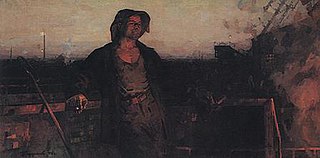This page is based on this
Wikipedia article Text is available under the
CC BY-SA 4.0 license; additional terms may apply.
Images, videos and audio are available under their respective licenses.

Ivan Andreyevich Krylov is Russia's best-known fabulist and probably the most epigrammatic of all Russian authors. Formerly a dramatist and journalist, he only discovered his true genre at the age of 40. While many of his earlier fables were loosely based on Aesop's and La Fontaine's, later fables were original work, often with a satirical bent.

Mayakovskaya, is a Moscow Metro station on the Zamoskvoretskaya Line, in the Tverskoy District of central Moscow.
Pine nut oil, also called pine seed oil or cedar nut oil, is a vegetable oil, extracted from the edible seeds of several species of pine. While the oil produced from the seeds of more common European and American pine varieties is mostly used for culinary purposes, Siberian pines, as well as Korean pines yield the seeds with the highest content of pinolenic acid, as well as antioxidants associated with medicinal uses.
The Irbit State Museum of Fine Art contains some important works including etchings by famous European artists. At the moment the museum is the only one in Russia specializing in engravings. In its collection there are engravings by Italian, Dutch, Flemish, German, French, English, Spanish, Swiss, Austrian, Polish, Bulgarian, Belgian, and North American artists. The collection includes works from Albrecht Dürer to Francisco Goya. In 2012 the museum unveiled a major oil work by Peter Paul Rubens to add to its collection of his etchings. Russian art is represented by the works of A. F. Zubova, I. A. Sokolova, E. P. Chemesova, Mikhail Dobuzhinsky, Alexander Deyneka, and many others. The domestic collection represents the artists of Yekaterinburg and Nizhny Tagil.

The Association of Artists of Revolutionary Russia (Russian: Ассоциация художников революционной России,

Alexander Mikhailovich Lubimov was a Russian Soviet realist painter, graphic artist, illustrator, and art teacher, professor of Repin Institute of Arts and Vera Mukhina Higher School of Art and Industry, who lived and worked in Leningrad. He was a member of the Leningrad Union of Artists and regarded as one of founder and the brightest representatives of the Leningrad school of painting, most famous for his portrait paintings and satirical drawings.
The year 1957 was marked by many events that left an imprint on the history of Soviet and Russian fine arts.
The year 1958 was marked by many events that left an imprint on the history of Soviet and Russian Fine Arts.
The year 1955 was marked by many events that left an imprint on the history of Soviet and Russian Fine Arts.
The year 1968 was marked by many events that left an imprint on the history of Soviet and Russian Fine Arts.
The year 1969 was marked by many events that left an imprint on the history of Soviet and Russian Fine Arts.
The year 1932 was marked by many events that left an imprint on the history of Soviet and Russian Fine Arts.
The year 1938 was marked by many events that left an imprint on the history of Soviet and Russian Fine Arts.
The year 1939 was marked by many events that left an imprint on the history of Soviet and Russian fine arts.

The Institute of Russian Realist Art (IRRA) is a private institution which brings back the public and social traditions of Russian artistic patronage. The IRRA museum and exhibition centre was opened on December 1, 2011 in one of the old buildings of the former cotton-printing factory built in the "Zamoskvorechye" district of Moscow at the end of the 19th century. The IRRA art collection is widely regarded as one of the best collections of the Russian realist school of painting of the 20th century. Three floors of exhibition space totaling over 4,500 square meters offer approximately 500 works of Russian and Soviet art.

The All-Union Art Exhibition devoted to the 40th anniversary of the October Revolution was one of the largest art exhibitions in Soviet history. Exhibition took place in Manezh Exhibition Hall from November 5, 1957 to May, 1958.

First National Art Exhibition "Soviet Russia" was one of the largest Soviet art exhibitions of the 1960s. The exhibition took place in Manezh Exhibition Hall.
The Kharkiv State School of Art is an educational institution in Kharkiv, Ukraine. It accepts a new class of students each year for instruction in the subjects of visual arts education, sculpture, decorative arts, graphic design, and landscape architecture.








